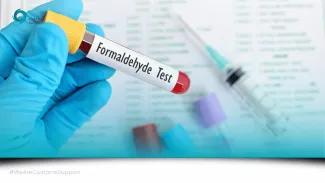Formaldehyde
One of the most commonly found dangerous gases is Formaldehyde. Formaldehyde is a colourless gas with a sharp and irritating smell. It's noticeable even in low concentrations, and regular exposure can lead to serious health issues. Common complaints after coming into contact with formaldehyde are headaches, irritations to the skin. Prolonged or frequent exposure to formaldehyde can lead to asthma and even cancer.
Contamination by evaporation
Formaldehyde is widely used in certain glues and in pressed wood products like pallets or dunnage materials. It dissolves easily into air and water. The problem with containers and other confined spaces is that the concentration of formaldehyde can get high due to lack of airflow. The higher the temperature, the more formaldehyde is released into the air. In summer measurements between 1 and 10 ppm (parts per million) are no exception, and the legal limit for formaldehyde is 0.12 ppm in The Netherlands!
Ventilation
In order to prevent increased concentrations of dangerous gases, it is important to ventilate properly. In enclosed spaces like shipping containers, this is not always possible. In those cases, you need to actively degas the container with appropriate equipment. Degassing or ventilating doesn’t stop the formaldehyde from dissolving into the air from pallets, wood, or glue. It does bring the levels below the danger level, making it possible to safely unload the container for only a limited time.
Given the fact that the levels of formaldehyde will start going up again after you finish ventilating the container, it is essential to unload the container shortly after you finish the degassing process. Ventilated containers should not be moved over long distances after degassing.
Warehouses and Confined Spaces
The problem of increased concentrations of dangerous gases like formaldehyde also takes place after unloading. When the goods are stored in the warehouse formaldehyde can keep dissolving in the air. To ensure a safe working environment for your warehouse workers, we advise you to periodically measure gas levels in your warehouse as well.
Very much like a shipping container, most confined spaces have only one point of entry. Often confined spaces are poorly ventilated and there isn’t much room to move around freely. Confined spaces are not designed for long stays, but when it comes to gas even a short stay can be dangerous and harmful.
Examples of confined spaces are storage tanks, cargo holds, basements, silos, ducts, or sewers. These should be monitored for dangerous gas levels as well.
Pre-emptive Measures
From an operational point of view, you can solve issues with dangerous gases like formaldehyde at the source. Take for example glued multiplex pallets: these could be replaced by slip sheets or non-glued pallets.
In this case, it is essential to perform an extensive risk analysis on your incoming container flows. Through risk analysis, it is possible to determine which flows have a high risk of dangerous gas levels, and which flows have a low risk. Gas measurements can then be used more efficiently, focussing your efforts on flows with higher risk, and only do sample checks in your low-risk flows.
At Your Service
Whether you want a container checked for dangerous gas, or want to measure gas levels in your warehouse or another working environment, or if you want a risk analysis done on your incoming container flows, Customs Support Safety has highly trained and experienced specialists to help you with any gas-related question or issue you may have. Contact one of our specialists if you have any questions.















